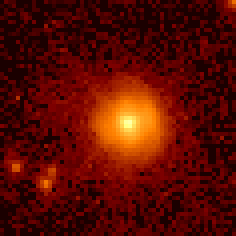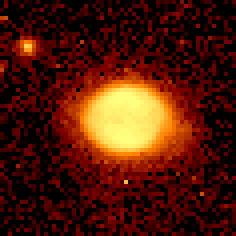

|
Magellanic Cloud Planetary NebulaeHome · Observations · Images · Analysis · Papers |

|
LMC-SMP-4Emission lines detected: H-alpha; [N II] 6584, 6548; [O III] 5007, 4959; H-beta.Elliptical Planetary Nebula with multiple shell features. The outer shell is faint and attached (no surface brightness minimum between shells). The inner shell is clearly elliptical, with no sign of bipolar shape or any other asymmetry or structure. It present an (elliptical) inner cavity, reminder of a 2-wind evolution. |

|
LMC-SMP-27This object has the same quadrapolar morphology in all detected lines, including the broadband image. In addition, two more extended nebular features are evident, though faint, in H-alpha, [O III] 5007, and the broadband image. The outermost is an arc approximately 6".25 to the NE, which is directed inward (to the CS), with a curvature that is somewhat larger than that of a circle centered on the CS. This arc is approximately 7".5 long and 0".5 wide, and has a surface brightness ~10 times fainter than the central nebula. The other feature is a blob centered approximately 4".8 to the N, with dimensions 2".7 x 1".0, with a similar surface brightness to the arc. The blob is roughly aligned (within a few degrees) of the major axis of symmetry of the inner nebula.* Inner nebula dimensions nearly circular, 9.5 pix = 0".48 radius (0.12 pc). Faint outer arc to NE, 123 pix = 6".27 (1.53 pc) separation, 174 pix = 7".5 long, 10.6 pix = 0".5 wide; PA of arc is 140.5 deg. Faint outer blob 14.6 deg W of N, ~95 pix = 4".8 separation. Emission Lines detected: H-alpha; He I; [N II] 6584, 6548; [O III] 5007, 4959; H-beta. The central (bright) region of this object is very highly ionized: there is no detection of [S II], [O I], and only very weak [N II]. On the other hand, [O III] 5007, 4959 is very strong relative to H-beta, and He I 6678 is easily detected. A ratio of the [O III] 5007 to H-alpha images shows a relatively uniform inner structure, though the ratio falls to roughly one-third of that value in the outer structure. Though the ionization apparently falls off, the ratio could be affected by an enriched O abundance in the inner region. It is very tempting to associate the outer features with the central PN, especially since it is otherwise not obvious how this gas came to be ionized. The features are not quite circularly symmetric, though this is not unusual for PNe in the Galaxy. Also, the outer features are at the limit of detection on these images, and other features may lurk beneath the noise. This object has a measured expansion velocity of 33 km/s. If this velocity were constant thoughout the life (and spatial extent) of the nebula, the implied dynamical age is 3500 yr for the inner region, and 45,400 yr for the outer arc. Interestingly, the interval of ~42,000 yr from the ejection of the outer envelope to that of the inner is consistent with what one would expect for a "born again" CS, in which a late thermal pulse during the PNN evolutionary phase forces the CS to repeat its path through the PNN domain. However, the nebular morphology and the inferred amount of material in the inner shell are both inconsistent with this interpretation. A more likely explanation for the outer ionized structure is that the ionization front from the inner nebula has encountered remnant gas from the AGB wind that preceeded the formation of the inner nebula, and the subsequent evolution of the CS to high temperature. Recall, however, the near-alignment of the ionized blob and the symmetry axis of the inner nebula. Another possibility (at least for the blob) is that it lies in the path of a (remnant?) jet of material from the CS. |

|
LMC-SMP-59This object has quadri-polar morphology in all detected lines, including the broadband image. This object shows a lot of internal structure, with a very knotty major axis, and a fainter minor axis that is not orthogonal to the major axis.Emission Lines detected: H-alpha; [N II] 6548,84 [S II] 6716,31, [O I] 6300, [O III] 5007, 4959; H-beta. This object is moderately ionized. |

|
LMC-SMP-95This object has bi-polar morphology in all detected lines, including the broadband image, although the low-ionization lines are less intense in the central region, giving a more ring-like appearance.Emission Lines detected: H-alpha; He I 6678; [N II] 6548,84 [S II] 6716,31, [O I] 6300,63, [O III] 5007, 4959; H-beta. The central (brightest) region of this object is very highly ionized. |